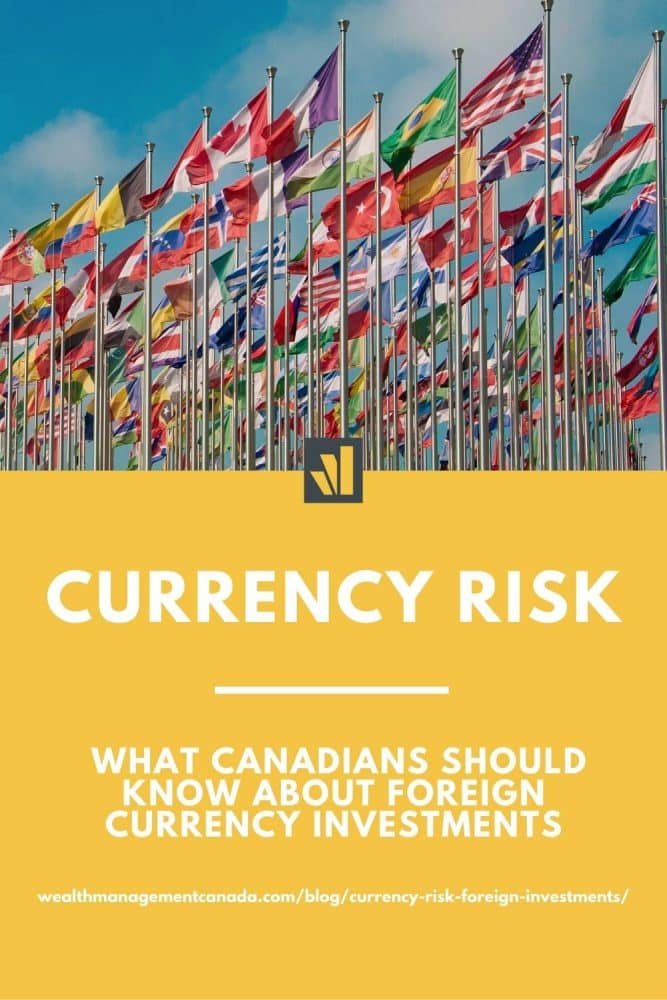Investors have a tendency to over-invest in their domestic market, as opposed to foreign currency investments. This bias is known as “local bias” or “home bias” in behavioural finance. This means that instead of building globally exposed portfolios, Canadians prefer to stick closer to home. We invest in Canadian companies trading on the Toronto Stock Exchange (TSX) or other local exchanges because it’s what we know and are familiar with.
For Canadians, the problem with home bias is the lack of diversification. Canada’s stock market is highly concentrated in a few sectors — with finance and energy at the top of the list. These account for a small percentage of global investment opportunities. By not investing in foreign markets, Canadians are losing out on opportunities for building wealth.

Table of contents
Understanding foreign currency risk
To build a globally diversified portfolio, Canadians need to look beyond our borders, buying non-Canadian investments. When investing in US, European, or Asian companies trading on foreign stock market exchanges, we use their respective currencies to make the purchase. The Canadian investor’s portfolio becomes exposed to other currencies and the movements in exchange rates of those foreign currencies and the Canadian dollar. This is foreign currency risk or foreign exchange (FX) risk.
What is currency risk?
When Canadians purchase investments denominated in another currency (e.g., Euro, USD, or Japanese Yen), two factors now play a role in determining your total return. The first is the performance of the investment and the second is fluctuations in the currency exchange rate.
For example, take a Canadian investor who buys one share of Company X, trading in Europe at a cost of 100€/share. At the time of purchase, the CAD/EURO exchange rate was 1.7. This means it costs the Canadian investor $170 CAD to make the purchase. Next, the investor decides to sell their investment, but today the CAD/EURO exchange rate is 1.6. This means that for 100€ you receive $160 CAD. So, if Company X stock is still trading at 100€/share and there’s no loss on the share price, the Canadian investor would still have a negative return on their investment. The loss is $10 CAD or 5.9%. If the exchange rate had gone to 1.8, then the Canadian investor would have had a positive return of $10 CAD or 5.9%. For a European investor, the return would be 0% in both situations as they’re dealing in their home currency.
These fluctuations in exchange rates are known as currency risk. It can have a positive or a negative effect on the total return on foreign investment. There’s no one-size-fits-all solution for approaching currency risk. Investors who don’t understand the effect of exchange rates on investment returns may simply ignore currency risk. Those who understand these dynamics make conscious decisions about how to deal with currency risk within a portfolio.
Managing currency risk
Hedging is one way to protect a portfolio from currency risk. Hedging strategies can be complex and require a unique set of skills — different from traditional portfolio management. These hedging strategies are typically executed using derivatives like currency options or futures (outside the scope of this article). They can also be expensive to implement, especially in small or medium-sized portfolios.
For the purpose of this discussion, think of hedging as an insurance policy. By using, or rather purchasing, other investments available in the marketplace, one can protect the portfolio from adverse foreign currency movements. However, the investor also gives up the potential of positive returns that could result through favourable foreign currency movements. Currency hedging removes the influence of currency fluctuations from the return on investment. Removing currency from the equation? A Canadian investor and a European investor would have the same return on a Euro-denominated investment
Investment professionals have different views on the value of using currency hedging strategies in equity portfolios. Some believe it’s prudent to remove this risk from the portfolio. Others believe the benefit of hedging doesn’t outweigh the cost of hedging.
Long-term investors tend not to be as concerned about short-term currency fluctuations. These investors are less likely to hedge currency risk. On the other hand, short-term traders are much more concerned with currency fluctuations in the near term. This is due to the fact that foreign exchange rates can have a significant impact on returns in the short term.
Currency risk and fixed-income portfolios
Hedging strategies tend to be more commonly used in foreign fixed-income portfolios. This is thanks to the nature of fixed-income investments and their role in portfolios
Typically, a bond will pay semi-annual interest payments to the bondholder. The shorter-term currency fluctuation can have a significant effect on those payments when converted back to the investor’s home currency, positive or negative. Since bond returns tend to be lower than equity returns, currency fluctuations can have a much greater effect on total returns than in the case of equity investments. Furthermore, if the investor is relying on those interest payments for income, it’s important they receive exactly the amount they are expecting. For these reasons, hedging against currency risk in foreign fixed-income portfolios is more common.
To hedge or not to hedge currency risk?
That depends. Speak with your wealth manager to figure out if your portfolio should be hedged against currency risk. Some of the factors that determine whether to hedge or not and how to set up the hedging strategy?
- Underlying investments
- The foreign currencies exposed to your portfolio
- Investment time horizon
- The cost of hedging
Related reading: Evaluating a wealth manager using the 4 Ps of manager research
We created WMC with the vision of helping Canadians gain access to the best financial resources in order to invest their money wisely based on informed decisions. Complete the online questionnaire or send us a message through our contact form to get started.